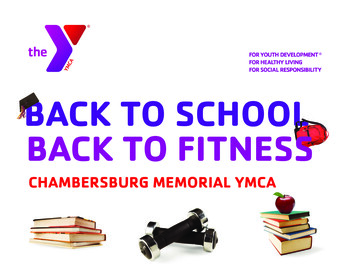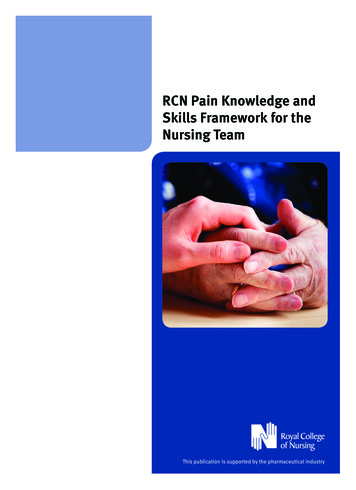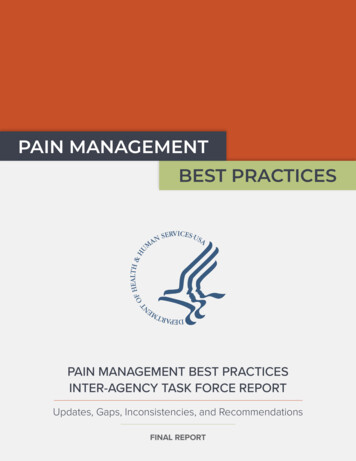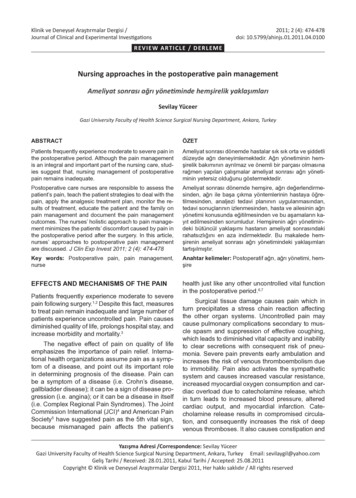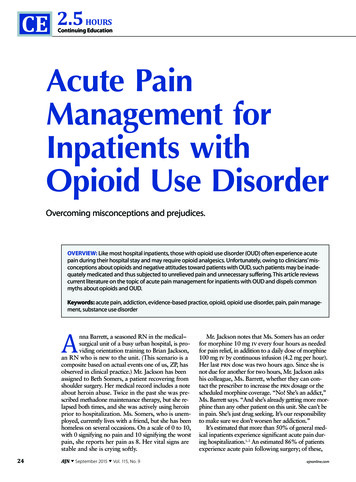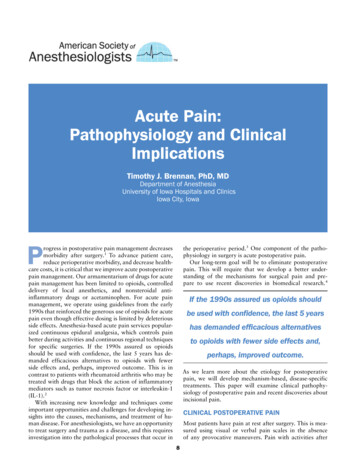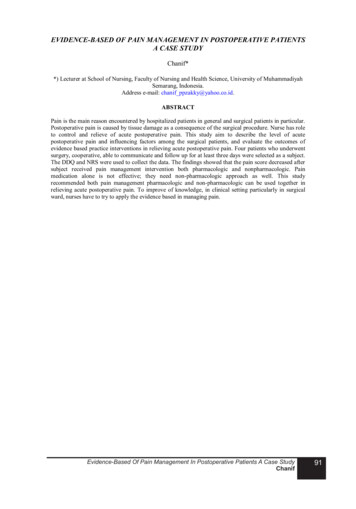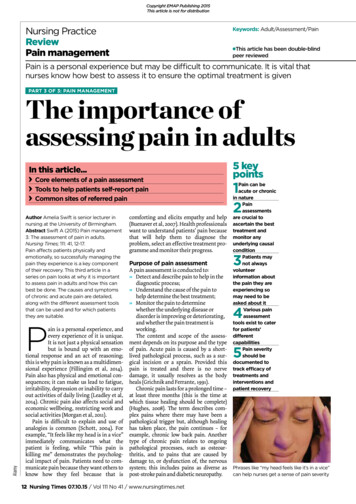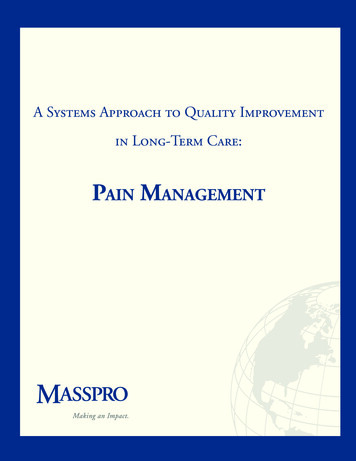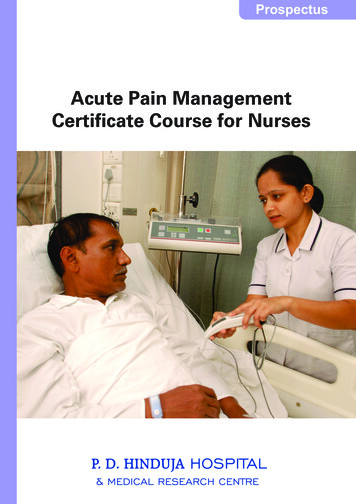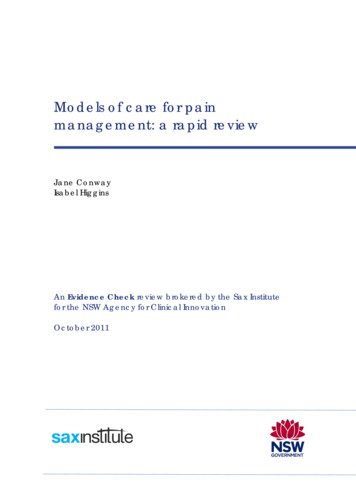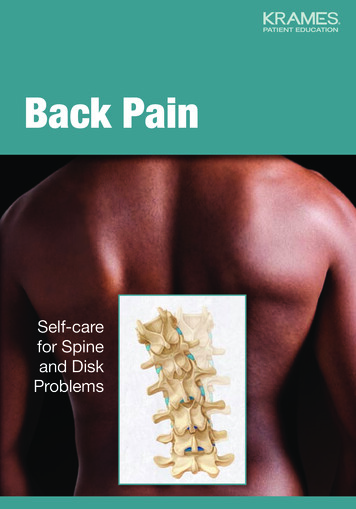
Transcription
Back PainSelf-carefor Spineand DiskProblems
Movement Keeps Your Back AliveTo stay healthy, your back needs to keep moving. The right kindsof motion are good for your back and help keep it pain-free. Butmoving the wrong way can lead to back problems. The good newsis that many people with back problems can find relief throughself-care. Read on to learn the back basics you need to movesafely each day.When Back Pain StrikesSometimes it comes as the sharp pain of a suddeninjury. At other times, back pain is a passing twingeor a constant ache. But in any case, back pain canlimit your life. Back pain may occur if you keepmoving in the wrong way. Or, it may develop if youmove too little. No matter what causes it, you canhelp reduce and prevent back pain with self-care.This product is not intended as a substitute for professional medical care.Only your doctor can diagnose and treat a medical problem. 2010 The StayWell Company. www.krames.com 800-333-3032 All rights reserved.2
A Team Approach to TreatmentAfter diagnosing your back problem, your doctor will prescribe atreatment plan that’s right for you. Depending on your problem,your doctor may want you to work with a physical therapist. Anexpert in safe movement and exercise, a physical therapist can teachyou easy techniques for self-care. By using these techniques asdirected, you can improve your symptoms. Even in cases whensurgery is needed, self-care is crucial to recovery.Self-Care Can HelpIn many cases, self-care is all that’s needed to treat your backproblem. You may want to start by learning about the spine.Doing so can help you see how proper movement can protectyour back. Then, by using good body mechanics and doingcertain exercises daily, you’ll be able to move more safely.3
Understanding a Healthy SpineA healthy spine supports the body while letting it move freely.It does this with the help of three natural curves. Strong,flexible muscles help, too. They support the spine by keepingits curves properly aligned. The disks that cushion the bonesof your spine also play a role in back health. When all theseparts of the spine are healthy, the lumbar curve (lower back)can support most of the body’s weight without pain.Three Natural CurvesThe spine is made of bones (vertebrae)and pads of soft tissue (disks). Theseparts are arranged in three curves. Whenproperly aligned, the curves keep yourbody balanced. They also support yourbody when you move. By distributingyour weight throughout your spine, thecurves make back injuries less likely.CervicalcurveThoraciccurveStrong, Flexible mstringmusclesStrong, flexible back muscles help supportthe three curves of the spine. They do soby holding the vertebrae and disks inproper alignment. If the abdominal, hip,and leg muscles are also strong and flexible,they can reduce strain on the back.QuadricepsmusclesThe back’s three natural curvesare correctly aligned when theears, shoulders, and hips are ina straight line.4
Spinal cordThe Lumbar CurveVertebraThe lumbar curve is the hardest-working part ofthe spine. It carries more weight and moves themost. Aligning this curve helps prevent damageto vertebrae, disks, and other parts of the spine.DiskThe facet is ajoint betweenvertebrae.The foramen is anopening betweenvertebrae.VertebraNerves exitthrough foraminaand branch outto your body.AnnulusNerves in thespinal canalDiskNucleusTOP VIEWCushioning DisksDisks are the soft pads of tissue between the vertebrae. The disksabsorb shock caused by movement. Each disk has a spongy center(nucleus) and a tougher outer ring (annulus). Movement withinthe nucleus allows the vertebrae to rock back and forth on the disks.This provides the flexibility needed to bend and move. Disk size,shape, and flexibility change throughout the day.duiuidFlFliddFluuiFluid stays in diskDuring the day,movement pushesfluid in and out of thenucleus. This keepsthe disk healthy.FlidFluWhile you sleep,the nucleus fills withfluid. This increasespressure in the disk.MovementYour disks changeFluid moves in andout of disk5
How the Spine Becomes UnhealthyAn unhealthy spine often starts with bad habits. Poor movementpatterns and posture problems are common causes of back pain.They can damage the spine or throw it out of alignment. Over time,bad habits can even cause disks to wear out early.Poor Posture BackfiresSooner or later, poor posture can cause pain. Too much slouching putspressure on the annulus. An excessive lumbar curve can overload andinflame the facets. As a result, the back muscles may tighten or spasmto “splint” and protect the spine. This adds to the pain you feel.Slouching (flexion) puts pressureon the annulus.An excessive lumbar curve(extension) harms the facets.StenosisNormal diskNarrowed diskBone spursDried-outdiskIrritatednerveHow Disks Wear OutOver time, normal aging often causes disks to wear out (degenerate). Butpoor movement and posture problems can speed up the process. As disks dryout and narrow, the vertebrae get closer together and become irritated. Bonyoutgrowths, or spurs, may form. This can narrow the foramen (a processcalled stenosis) and irritate nearby nerves.6
Common Spine and Disk ProblemsThe most common back problems occur when disks tear, bulge,or rupture. In such cases, an injured disk can no longer cushion thevertebrae and absorb shock. As a result, the rest of your spine mayalso weaken. This can lead to pain, stiffness, and other symptoms.RupturedannulusPressureon itatednerveTorn annulus. A suddenmovement may cause a tinytear in an annulus. Nearbyligaments may stretch.Bulging disk. As a disk wearsout, the nucleus begins to bulgeinto the annulus.Ruptured disk. As a diskruptures, its nucleus cansqueeze out and irritatea nerve.InflamedfacetsPressureon annulusBonespursIrritatednerveArthritis. As disks wear outover time, bone spurs form.These growths can irritatenerves and inflame facets.StressfracturePressureon annulusStretcheddiskSlippingvertebraeInstability. As a disk stretches,the vertebrae slip back andforth. This can put pressure onthe annulus.StretcheddiskSpondylolisthesis. A crack(stress fracture) can developin a vertebra. This may putpressure on the annulus, stretchthe disk, and irritate nerves.7
Diagnosing Your Back ProblemA medical evaluation is needed to find the cause of your backproblem. This can include a health history, an exam, and diagnostictests. After diagnosis, a team approach to treatment often worksbest. Each team member—the doctor, the physical therapist, andyou—plays a role in improving the health of your back.Your Health HistoryYour health history helps the doctorevaluate your back pain and othermedical problems. Your doctor islikely to ask about what symptomsyou feel and when you notice them.An ExamTo find the cause of your problem,your doctor may check your spine andposture in different positions. Yourmuscle flexibility and strength maybe checked. The reflexes and sensationin your legs may also be tested.Diagnostic TestsTo locate the source of your pain, youmay have one or more tests. Imagingtests, such as x-rays, CTs, and MRIs, alsohelp the doctor plan your treatment.MRI of the lumbar spine withbulging diskWhen to Call Your DoctorCall your doctor right away if you have back pain and any of the following: Problems controlling your bladder or bowels Numbness near the genital or rectal area Extreme leg weakness, numbness, or constant leg pain Fever or chills8
Proper Posture: The Key to Safe MovementYour spine bears your weight throughout the day. This is truewhether you’re sleeping, standing, or bending. Certain positionsplace more strain on your spine than others. But by maintainingproper posture in all positions, you can reduce the stress onyour spine. This helps to prevent back pain and injury.Learn which positions place excesspressure on your disks. Then do yourbest to limit the amount of time youspend in high-stress positions.LYING ONYOUR BACKLYING ONYOUR ITH A10-POUNDWEIGHTSLOUCHINGWITH A10-POUNDWEIGHTCheck YourStanding PostureTo improve your standing posture, follow these steps: Breathe deeply. Relax your shoulders, hips, and knees. Think of the ears, shoulders, hips, and anklesas a series of dots. Now, adjust your body toconnect the dots in a straight line. Tuck your buttocks in just a bit if you need to.9
Learning Safe Body MechanicsIf you sleep, sit, and move the right way, your weight is balancedthroughout your spine. As a result, the risk of back injury isreduced. You may want to learn safe body mechanics a step ata time. Think about which movements cause your symptoms.Then learn the correct back basics for those movements first.Lying Down When lying on your side, bend yourknees and place a pillow between them. If you lie on your back, put a pillowunder your knees. If you lie on your stomach, place apillow under your abdominal muscles.Standing Bend your knees slightly to take stressoff your lower back. Wear shoes that support your feet.This helps keep your spine aligned. If you must stand for long periods,raise one foot slightly. Rest it on alow shelf or stool. Shift feet often.Sitting Sit in chairs that support your back.Keep your ears in line with your hips.If needed, support your lumbar curvewith a rolled-up towel or lumbar roll. Your knees should be level with yourhips. Your feet should be flat on thefloor or on a footrest.10
Bending and Lifting Bend at your knees and hips insteadof your waist. Do your best to keepyour hips in line with your shoulders. Hold objects close to your body tolimit strain on your back. Lift your body and the load at thesame time. Let your leg muscles domost of the lifting.Turning Think of your upper body as onestraight unit, from your shouldersto your buttocks. Turn with your feet, not your back orknees. Point your feet in the directionyou want to go. Then step around andturn. Maintain your spine’s three curves.Reaching Store common items between shoulderand hip level. Get close to the item. Use a stool orspecial reaching tool, if you need to. Tighten your abdominal muscles tosupport your back. Use the musclesin your arms and legs (not your back)to lift the item.11
Exercise for a Healthier BackYour healthcare provider can create an exercise program to fit yourneeds. Do your exercises each day, or as often as directed. Try torepeat each exercise as often as instructed. Stop any exercise thatcauses pain. Then tell your doctor or physical therapist.Neck Glide Sit or stand up straight. Keep your chin level. Glide your head straight back. (You shouldfeel as if you have a double chin.)Pelvic Tilt Lie down and bend both knees. Tighten your abdominal and buttockmuscles. Tilt your hips slightly towardthe ceiling until your lumbar curveflattens against the floor.Hamstring Stretch Lie on your back. Place a towel or yourhands around your thigh, just above theknee. Tighten your abdominal muscles. Pull your leg toward your chest untilyou feel a stretch. Gently straightenyour leg as much as you can.Partial Sit-Up Lie on your back with both knees bentand your feet flat on the floor. Fold yourarms across your chest. Use your abdominal muscles to raise yourbody. Keep ears and shoulders aligned. Pause when your shoulder blades comeoff the floor. Relax back down.12
Hip Stretch Kneel with one foot in front of you. Tightenyour abdominal muscles. Slowly shift your weight forward onto yourfront foot. You should feel a gentle stretchon the back hip.Wall Slide Stand with your back against a wall. Placeyour feet about 12 inches in front of you,shoulder-width apart. Tuck your buttocksuntil you feel comfortable. Slide down the wall into a half-sit. Be sure tokeep your back against the wall. Your kneesshould not go beyond your toes.Press-Up Lie on your stomach. Place your handson the floor near the sides of your head. Straighten your arms and push yourupper body off the floor. Be sureto keep your hips in contactwith the floor. Slowly bend your elbows, allowing yourupper body to relax down to the floor.Note: Do press-ups only if your healthcareprovider says that you should.13
Think Back Throughout the DayTake care of your back throughout the day. You will have fewerback problems if you do. Try to warm up before you move. Shiftpositions often. Also do your best to form healthy habits.Warm Up for the DayShift Positions OftenDo a few slow, catlike stretches beforestarting your day. This simple warm-upcan soften your disks, stretch yourback muscles, and helpprevent injuries.At work and at home, change positionsoften. This helps keep your body fromgetting stiff. Stand up or lean back whileyou sit. If you can, get up and moveevery half-hour.Form Healthy Habits Keep a healthy weight. When you weigh too much, your back is underexcess strain. But losing just a few extra pounds can help a lot. Try not to overeat. Learn about serving sizes. The size of a servingdepends on the food and the food group. Many foods list serving sizeson the labels. Handle minor aches with cold and heat. Apply cold the first 24 to48 hours. Use heat after that. Always place a cloth between your skin andthe source of cold or heat. Take medications as directed. This helps keep pain under control. Alwaysread labels, and call your doctor or pharmacist if you have any questions.14
Walk to Better Back FitnessWalking is great for your back. It’s as simple as taking astep out the door. And if you always wear good walkingshoes, it’s that much better for your back.Walk Each DayA daily walk keeps your back and thighmuscles stretched and strong. This givesyour back better support. Be sure to walkwith your spine’s three curves aligned.Getting StartedMake it a goal to walk 20 to 30 minuteseach day. A few hints for starting outare listed below. Start with a 5- to 10-minute walk. Thenadd a few more minutes each day. Take three 10-minute walks each day. Walk to visit a friend instead of talkingon the phone. Walk around the entire store or mallbefore you shop.Soft sockswith no seamsRoom to wiggleyour toesSecure heelthat won’t slipInstep that fitsthe size and shapeof your footWear the Right ShoesWhen you walk, wear a goodpair of walking or joggingshoes. These shoes absorbshock when your foot hitsthe ground. This helps thedisks cushion your spine.15
Moving Wisely, Moving WellYour healthcare team can teach you the basics of back careand good movement. But from there, back fitness may beup to you. Learn to move wisely. Then stay on the move.Whether you’re lifting, walking home from the store,or running around the block, the basics of safemovement help keep you on the go.Consultant:James B. Reynolds, MD, Orthopaedic SurgeryWith contributions by:Robert O. Buss, MD, Orthopaedic SurgeryAlan T. Hunstock, MD, FACS, NeurosurgeryCarla Gleaton, PT2211221Take our Patient Survey. Help ushelp other patients. Please visitwww.kramesurvey.com to provideyour feedback on this product.0909
curves make back injuries less likely. Strong, Flexible Muscles Strong, flexible back muscles help support the three curves of the spine. They do so by holding the vertebrae and disks in proper alignment. If the abdominal, hip, and leg muscles are also strong and flexible, they can reduce str
